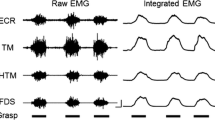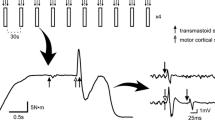Summary
The possible contribution of low threshold muscle afferents to the postsynaptic component (N13) of the cervical response evoked by electrical stimulation of the median nerve (MN) was investigated in normal subjects. Electroneurographic (ENG) and electromyographic (EMG) correlates of the reflex motoneuronal discharge (RMND) were recorded simultaneously. A. No reflex activity could be elicited by stimulation of the MN at the wrist, at least in the resting subjects, while well developed ENG (P2 efferent volley) and EMG (H reflex) monosynaptic responses occurred following stimulation of the MN at the elbow at suitable strengths. In neither case could a surface correlate of interneuronal activity evoked by muscle afferents be demonstrated. B. Recruitment curves showed that at stimulus intensities above maximal for the H reflex both P2 and H responses started to decrease until they completely disappeared, while N13 showed further enhancement. C. Subthreshold conditioning stimulation of the MN enhanced both P2 and H responses, while vibratory muscle stimuli provoked a clearcut suppression of these two responses. In contrast, N13 was completely unaffected by either manœuvre. D. No cervical evoked activity could be detected following tendon tapping of the anterior forearm muscles in spite of the appearance of well developed cortical responses and the ENG and EMG correlates of the T reflex. E. Conditioning volleys elicited by tendon taps of the anterior forearm muscles suppressed both P2 and H responses following stimulation of the MN at the elbow without affecting the related N13 component. F. Conditioning supramaximal stimulation of the MN at the wrist suppressed the N13 component of the cervical response evoked by stimulation of the MN at the elbow without affecting the related reflex responses. No component chronologically related to the RMND could be recorded at the posterior neck region during suppression of N13, thus ruling out the possibility that failure to detect the RMND (as well as its interneuronal concomitants) with cervical electrodes is due to a masking effect of the N13 component. G. Conditioning tendon taps of anterior forearm muscles provoked a clearcut reduction of the primary cortical response to finger stimulation without affecting the postsynaptic component of the related cervical response. It is concluded that neither segmental (motoneuronal or interneuronal in origin) nor ascending postsynaptic impulses generated in the spinal cord by stimulation of low threshold muscle afferents contribute to N13, the latter being probably due to activation of both short and long axoned spinal neurons by cutaneous afferents.
Similar content being viewed by others
References
Abbruzzese M, Ratto S, Abbruzzese G, Favale E (1985) Electroneurographic correlates of the monosynaptic reflex: experimental studies and normative data. J Neurol Neurosurg Psychiat 48: 434–444
Allison T, Wood CC, McCarthy G (1986) The central nervous system. In: Coles MGH, Donchin E, Porges SW (eds) Psychophysiology. The Guilford Press, New York, pp 5–25
Beric A, Dimitrijevic MR, Prevec TS, Sherwood AM (1986) Epidurally recorded cervical somatosensory evoked potential in humans. Electroenceph Clin Neurophysiol 65: 94–101
Bernhard CG (1953) The spinal cord potentials in leads from the cord dorsum in relation to peripheral source of afferent stimulation. Acta Physiol Scand 29 (Supp 106): 1–29
Bloedel JR, Courville J (1981) Cerebellar afferent systems. In: Brookhart JM, Mountcastle VB (eds) Handbook of physiology. The nervous system, Vol II, Part 2. Am Physiol Soc, Bethesda MD, pp 735–830
Burke D, Gandevia SC, McKeon B (1984) Monosynaptic and oligosynaptic contributions to human ankle jerk and H-reflex. J Neurophysiol 52: 435–448
Burke D, Gandevia SC, McKeon B, Skuse NF (1982) Interactions between cutaneous and muscle afferent projections to cerebral cortex in man. Electroenceph Clin Neurophysiol 53: 349–360
Cajal S, Ramon Y (1909) Histologie du système nerveux de l'homme et des vertébrés, Vol I. Maloine, Paris
Deschuytere J, DeKeyser C, Deschuttere M, Rosselle N (1983) H reflexes in muscles of the lower and upper limbs in man: identification and clinical significance. In: Desmedt JE (ed) Motor control mechanisms in health and disease. Raven Press, New York, pp 951–960
Desmedt JE, Nguyen TH (1984) Bit-mapped colour imaging of the potential fields of propagated and segmental subcortical components of somatosensory evoked potentials in man. Electroenceph Clin Neurophysiol 58: 481–497
Foreman RD, Kenshalo DR, Schmidt RF, Willis WD (1979) Field potentials and excitation of primate spinothalamic neurones in response to volleys in muscle afferents. J Physiol (Lond) 286: 197–213
Fukushima Y, Yamashita N, Shimada Y (1982) Facilitation of H-reflex by homonymous Ia-afferent fibers in man. J Neurophysiol 48: 1079–1088
Gandevia SC, Burke D, McKeon B (1984) The projection of muscle afferents from the hand to cerebral cortex in man. Brain 107: 1–13
Gasser HS, Graham HT (1933) Potentials produced in the spinal cord by stimulation of dorsal roots. Am J Physiol 103: 303–320
Gilliatt RW, Willison RG (1963) The refractory and supernormal periods of the human median nerve. J Neurol Neurosurg Psychiat 26: 136–147
Hagbarth KE (1962) Post-tetanic potentiation of myotatic reflexes in man. J Neurol Neurosurg Psychiat 25: 1–10
Jewett DL, Rayner MD (1984) Basic concepts of neuronal function. Little Brown and Company, Boston, Massachusetts, p 266
Leandri M, Favale E, Ratto S, Abbruzzese M (1981) Conducted and segmental components of the somatosensory cervical response. J Neurol Neurosurg Psychiat 44: 718–722
Lloyd DPC (1955) Synaptic mechanisms. In: Fulton JF (ed) A textbook of physiology. WB Saunders Company, Philadelphia London, 17th edn, pp 69–90
Ratto S, Reni L, Abbruzzese G, Abbruzzese M, Favale E (1986) Facilitation and inhibition of synaptic transmission in the spinal cord: an electroneurographic study in humans. Exp Brain Res 64: 411–420
Rustioni A, Hayes NL, O'Neill S (1979) Dorsal column nuclei and ascending spinal afferents in macaques. Brain 102: 95–125
Shimoji K, Shimizu H, Maruyama Y (1978) Origin of somatosensory evoked responses recorded from the cervical skin surface. J Neurosurg 48: 980–984
Sunderland S (1968) Nerve and nerve injuries. Edinburgh, Livingston, pp 758–764
Vogel P, Ruber P, Klein R (1986) The latency difference of the tibial and sural nerve SEP: peripheral versus central factors. Electroenceph Clin Neurophysiol 65: 269–275
Wall PD (1960) Cord cells responding to touch, damage, and temperature of skin. J Neurophysiol 23: 197–210
Willis WD (1984) Evoked spinal cord potentials in the cat and monkey: use in the analysis of spinal cord function. In: Homma S, Tanaka T (eds) Fundamentals and clinical application of spinal cord monitoring. Saikon Publ Company, Tokyo, pp 3–19
Yates BJ, Thompson FJ, Parker Mickle J (1982) Origin and properties of spinal cord field potentials. Neurosurgery 11: 439–450
Author information
Authors and Affiliations
Rights and permissions
About this article
Cite this article
Reni, L., Ratto, S., Abbruzzese, G. et al. Do muscle afferents contribute to the cervical response evoked by electrical stimulation of the median nerve in man?. Exp Brain Res 72, 305–315 (1988). https://doi.org/10.1007/BF00250253
Received:
Accepted:
Issue Date:
DOI: https://doi.org/10.1007/BF00250253




